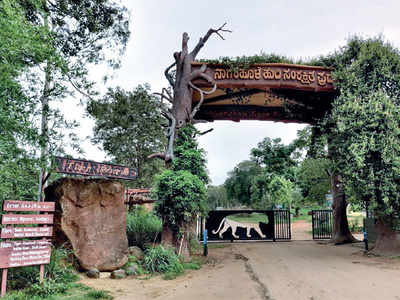The Nagarhole wildlife sanctuary, is often considered to be the ‘finest tiger turf in the country’. Nagarahole is also one of the best places to see Asiatic Elephants in all of India. It is part of the Nilgiri Biosphere Reserve, which consists of a contiguous complex of Protected Areas in Southern India.
The national park derives its name from the word ‘Nagarahole’ also known as the Snake River which flows through the Northern end of the National Park. The Southern end is drained by the beautiful Kabini river which has now been dammed to create a large reservoir, much of which lies within the region of the National Park. The waters of this lake region support crocodiles and otters. Other animals include Leopards, Wild Dogs, Gaurs, Sambars, Chital and Barking Deer respectively.

Image Credits: Times of India
The birds of Nagarahole are diverse with Malabar Trogon, Indian Great Black Woodpecker, Blyh’s Baza, Crested Serpent Eagles, Osprey, Peregrine Falcon, Scarlet Minivets, Blackheaded Cuckoo Shrikes, various species of Barbets, Owls, Cuckoos, Flycatchers, and many more are spotted here.
Our resort in Kabini is one of the finest resorts to stay at in Kabini. You can relax and rejuvenate at our resort in Kabini during your stay here. During the day you can leave for safaris from our resort in Kabini and enjoy the beautiful wildlife of the National Park.
The name Nagarahole is derived from the meandering and winding river which flows through the Park and in Kannada the word ‘Naga’ means snake and ‘Hole’ means stream respectively. The stunning Nagarahole National Park is located in the foothills of the misty blue Brahmagiri mountain range and straddles the picturesque districts of Kodagu which is Coorg and Mysore also. Initially constituted as a Sanctuary in 1955, it was subsequently enlarged and conferred the status of a National Park in the year of 1974. The Southern end is drained by the Kabini river which is a tributary of the majestic river Cauvery which has now been dammed to create a large reservoir, much of which lies within the park and which today separates Nagarahole National Park from the Bandipur Tiger Reserve which is also a beautiful tiger reserve.

Image Credits: Indian One Place
Many hunter-gatherer tribes have inhabited these forests for several centuries and still live here today. Of the 1500 or so people that live within the park and an approximate 5 to 6 thousand on the fringes of it, most are tribals known as Jenu Kuruba, Betta Kuruba and Yerava. These tribes later took to slash and burn farming and collecting non-timber forest products for sale to many urban markets in South India. Today, many of these people work as labourers in coffee plantations or farms in the region and also engage in seasonal work provided by the Forest Department of Kabini.
Between 1870 and 1980, 14% of the area of the present Park was clear-cut to raise monocultures of teakwood. The dense secondary forests now occur in places where these plantations had failed. Until recently, both the moist and dry deciduous forests have been logged respectively.
The long term management goal of the British was to replace natural forests with the more profitable teak and they actively pursued this until the independence of the nation of India. Betqween 1947 and 1955, the new Indian Government’s long term policy turned to harvesting as much timber as possible, and to grow more food for the markets. Tribal and non-tribal people were encouraged to occupy Nagarahole’s ‘hadlus’, and they were encouraged to cultivate rice and in addition provided cheap logging labour too. There were no wildlife protection laws and hunting of predators was actively encouraged however in the year 1955, hunting of large mammals became illegal, but logging and encroachments into the Park still continued. It was only in the year 1974, when Nagarahole wildlife sanctuary was declared a National Park and tough new wildlife protections laws came into force that this situation started to change. In a complete reversal of roles, the management now tried to curb poaching, livestock grazing and removal of illegal encroachments which was a highly positive move! Between 1970 and 1980 about a thousand squatters were moved out of the Park into many resettlements.
The forest product exploitation was regulated in response to lobbying by wildlife conservationists and a core zone of two hundred square kilometers was demarcated to the exclusion of forestry activities and tourism.



